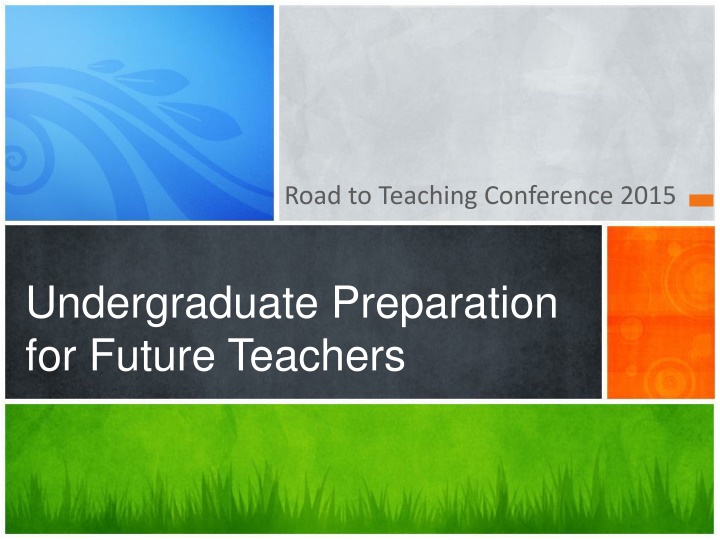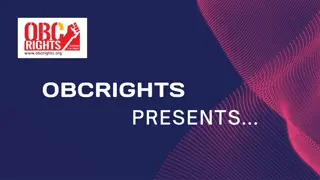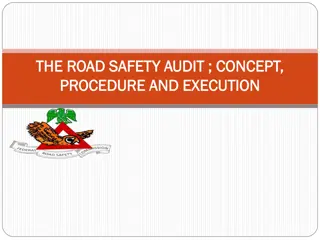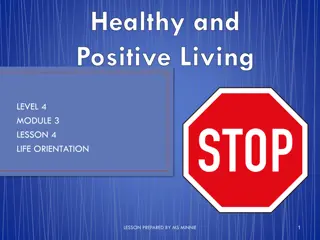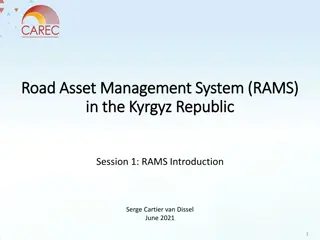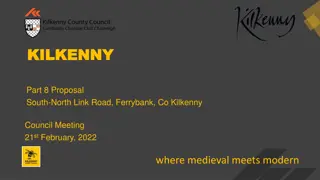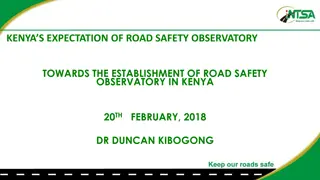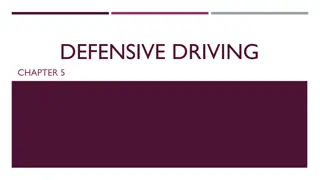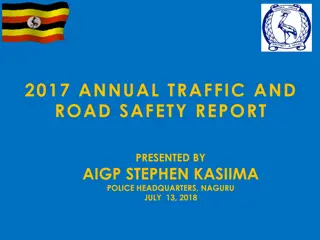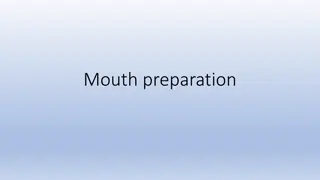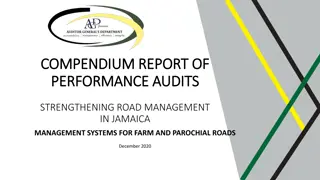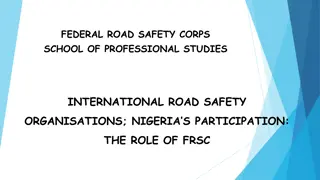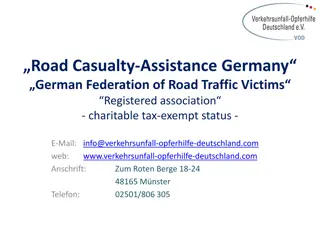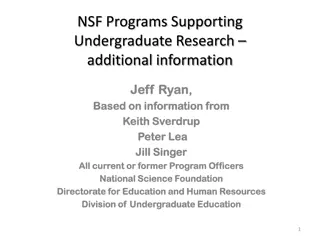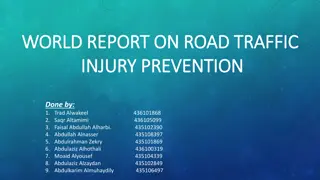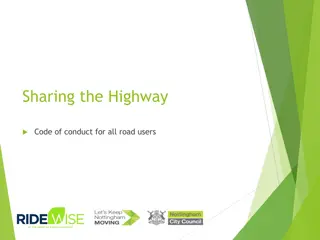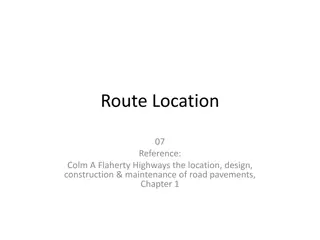Undergraduate Preparation for Future Teachers at Road to Teaching Conference 2015
In-depth overview of the pathways to becoming a teacher in California, emphasizing the importance of a Bachelor's degree and Teaching Credential. The process involves General Education exposure, subject matter courses, and specialized preparation programs to equip future educators with essential skills. Various images illustrate the journey from undergraduate studies to practical classroom training, highlighting the significant steps necessary for success in the teaching profession.
Download Presentation

Please find below an Image/Link to download the presentation.
The content on the website is provided AS IS for your information and personal use only. It may not be sold, licensed, or shared on other websites without obtaining consent from the author.If you encounter any issues during the download, it is possible that the publisher has removed the file from their server.
You are allowed to download the files provided on this website for personal or commercial use, subject to the condition that they are used lawfully. All files are the property of their respective owners.
The content on the website is provided AS IS for your information and personal use only. It may not be sold, licensed, or shared on other websites without obtaining consent from the author.
E N D
Presentation Transcript
Road to Teaching Conference 2015 Undergraduate Preparation for Future Teachers
Future Teacher Success Pathway General Education Credential Program Teacher Preparation To Teach is to Touch the Future!
General Education Provides broad exposure to multiple disciplines and forms the basis for developing essential intellectual, civic, and practical capacities.
If you want to be a teacher in California, you need A Bachelor s Degree + A Teaching Credential
Teacher Preparation Pathways Community College Undergraduate degree program High School (diploma or GED) Undergraduate degree program Credential program
Teacher Preparation Pathways General Education (100-200) Major Preparation GE Major coursework (300-400) Credential program preparation Major Teaching methods courses Student Teaching Credential
Teacher Preparation Subject matter courses, major choice
What does a teacher need to know? Subject matter (What you learn in the courses for your bachelor s degree) and How to teach (What you learn in the credential program) To teach is to touch the future .
Future Teachers Fulfill Multiple Sets of Requirements GE Major Subject Matter Preparation Credential Program Prereqs
Multiple Sets of Requirements For future teachers: Major Subject Matter Preparation GE Credential Program Prerequisites
Pathways to a Bachelors Degree Choose a major to suit your area of expertise: Elementary School Human Services Psychology Liberal Child/Human Development Studies Sociology Other
Pathways to a Bachelors Degree Choose a major to suit your area of expertise: Middle/High School Math Social Science Art History Geography Economics Political Science Criminal Justice Anthropology American Studies Science English Biology Chemistry Physics Geological Science Music Kinesiology Foreign Language
Credential Program Multiple Subject, Single Subject, and Special Education
What is a Credential Program? Traditionally , a two semester program following the Bachelor s degree; sometimes referred to as a 5th year program. Includes student teaching PEDOGOGY! Credential programs teach the methodology and practical applications of how to be a teacher
What type of credential do you need?
What Does a Multiple Subject Credential Authorize You to Teach? The Multiple Subject Teaching Credential authorizes the holder to teach all subjects in a self-contained classroom, such as the classrooms in most elementary schools.
What Does a Single Subject Credential Authorize You to Teach? The Single Subject Teaching Credential authorizes the holder to teach the specific subject(s) named on the credential in departmentalized classes, such as those in most middle schools and high schools.
What Does a Education Specialist Credential Authorize You to Teach? Credentials in Mild/Moderate and Moderate/Severe Disabilities authorize the provision of services to individuals in grades K through 12, and in classes organized for adults. Early childhood special education includes the provision of educational services to children from birth through pre- kindergarten who are eligible for early intervention, special education, and/or related services under federal and state laws.
Steps to a credential program Obtain a Bachelor s Degree Prove knowledge of basic skills CBEST: California Basic Educational Skills Test Prove subject matter competency CSET: California Subject Examinations for Teachers SMPP: Subject Matter Preparation Program (single subject only) Complete a course in the provisions and principles of the U.S. Constitution or pass an examination given by a regionally-accredited college or university. Complete any prerequisites and fieldwork.
Tests!!! Teachers have to take tests too! Don t worry! You can do it!!!
California Educator Credentialing Examinations www.ctcexams.nesinc.com
CBEST What is it? The CBEST is the California Basic Educational Skills Test that assesses you on basic skills in reading comprehension, math and writing skills through an 8th/9th grade level. Who is it for? Anyone who wants to substitute teach or desires a career as a classroom teacher must pass the CBEST or its equivalent.
Subject Matter Competency All teachers need to prove to the Commission on Teacher Credentialing (CTC) that they know their stuff For future elementary school teachers this is done by passing the Multiple Subject CSET test. For future middle/high school teachers this is done by passing the CSET in your area of curriculum specialty or complete a state-approved subject matter preparation program (SMPP)
State Approved Subject Matter Preparation Program Subject Matter Preparation Programs (SMPP) require students to take classes that cover the broad range of material found in the California Student Academic Content Standards. While most subject matter preparation programs can be completed within the context of the major, students must choose major electives carefully to simultaneously complete the requirements for the major and the SMPP. For many programs, classes are required in addition to the requirements for the major. SMPP = CSET
How Do You Prepare for the CSET? Choose a major to help prepare you in subject matter knowledge. Take classes to support your knowledge in the subject matter areas. Keep and review notes, exams and papers from all subject matter classes. Do the FREE practice test online at the CSET website www.ctcexams.nesinc.com
Subjects Available for Single Subject Teaching Credentials* Languages other than English Mathematics Foundational Level Mathematics Music Physical Education Physics Social Science Foundational Level General Science Agriculture Art Biological Sciences Business Chemistry English Geosciences Health Science Home Economics Industrial & Technology Ed. *Check your desired university to see if the credential you seek is offered
Credential Program Prerequisites Check with the universities you are interested in attending to see what are their specific prerequisites as they vary from school to school. Some universities offer blended programs where you can earn your bachelor s degree and teaching credential at the same time. Others may offer blended programs where you earn your teaching credential and Master s degree at the same time. Many universities offer their credential programs as a 5th year program completed the year after the bachelor s degree.
Choosing the Right Program for You Important things to consider Combined Bachelor s degree and Credential Post-baccalaureate course work recognition Combined Credential and Master s Program The Myth: Districts won t hire with a Master s Master s Degree as Professional Development Personal & Professional Opportunity
Choosing the Right Program for You Important things to think about Cohort v. non-cohort Cost
Cohort v. Non-cohort Credential Programs Just like degree programs are structured differently from university to university, so are credential programs! Some universities have structured their Multiple Subject and Single Subject Credential Programs to follow a cohort format: A cohort is a learning community in which all classes for the credential program contain the same students each semester. Each semester is specifically structured, the classes are arranged in a particular format, and you are guaranteed that you will be able to register for all of your classes.
Cohort v. Non-cohort Credential Programs (cont.) You build strong relationships and support structures with the other students and faculty members in your cohort. Limits ability to work outside program hours. Non-Cohort programs: Non-cohort programs are a little more flexible in regards to how you arrange your schedule and how many classes you take at a time. Allows more time to work outside program hours. May offer online options for course work. Program time completion varies.
Credentialing Costs Cost is an important factor when deciding on a credential program For academic year 2015-2016 $3658 (sem.) / $7316 (yr.)@ CSUF (2 semesters) $3664 (sem.) / $7328 (yr.) @ CSULB (2 semesters) $2625 (quar.) / $7875 (yr.) @ CalPolyPomona (3 quar.) $5498 (quar.) / $16,463 (yr.) @ UCI (3 quarters) 41credits@$840 per credit / $34,440 (18mos.) Chapman Univ.
Financial Aid Opportunities Direct Loans and Federal Stafford Loan Forgive $5000-$17500: www.federalstudentaid.ed.gov/tc Loan Cancellation Program Federal Perkins Loans: may cancel up to 100% of loan www.federalstudentaid.ed.gov/tc TEACH Grant (Teacher Education Assistance for College and Higher Education) http://studentaid.ed.gov K-12 public/private school May be awarded up to $4,000/yr. Full-time teacher in high need field and low-income area for 4 academic years (within 8 years of graduating)
Questions? Current High School Students - See a counselor Current Community College Students See a counselor( preferably in the Teacher Education program) Current University students See major advisor and/or teaching pathway advisor. www.fullerton.edu/cct Teaching Teaching is a work of is a work of
Caren Bautista STEM Teaching Coordinator California State University Fullerton Center for Careers in Teaching (657) 278-3368 cbautista@fullerton.edu
